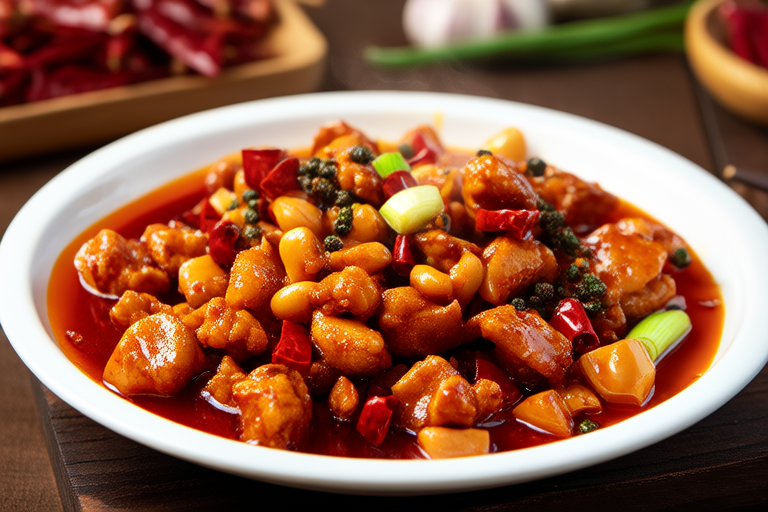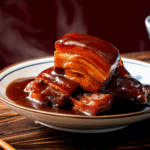Spicy Kung Pao Chicken – A Fiery Sichuan Delight
Welcome to my culinary journey where we explore the vibrant flavors of Sichuan cuisine. Today, we dive into one of the most iconic dishes from this region: Spicy Kung Pao Chicken. This dish is not just about the chicken; it’s about the harmonious blend of spices and chili peppers that create a fiery yet delightful experience for your taste buds. Let’s break down the recipe and understand what makes this dish so special.
The History Behind Kung Pao Chicken
Kung Pao Chicken, also known as Gong Bao Ji Ding in Chinese, has a rich history dating back to the Qing Dynasty. It was named after Ding Baozhen, a governor of Sichuan province who enjoyed this dish. The dish was originally made with peanuts and dried chili peppers, which were common ingredients in Sichuan cuisine due to their availability and the region’s climate.
Over time, Kung Pao Chicken evolved, adapting to different regions and preferences. In the United States, it became a staple in Chinese restaurants, often modified to suit local tastes. However, true aficionados of Sichuan cuisine will tell you that there’s nothing quite like the original, fiery version.
The Ingredients You’ll Need
To make authentic Spicy Kung Pao Chicken, you’ll need a few key ingredients:
- Chicken: Choose boneless, skinless chicken thighs or breasts for maximum flavor and tenderness.
- Dried Red Chili Peppers: These are essential for the heat and aroma of the dish.
- Peanuts: Traditionally, roasted peanuts are used, but you can also use cashews or almonds for a different texture.
- Soy Sauce: Use light soy sauce for a milder flavor and dark soy sauce for color and depth.
- Ginger and Garlic: Fresh ginger and garlic add a layer of complexity to the dish.
- Scallions: Finely chopped scallions are used for garnish and added freshness.
- Sugar: A small amount of sugar balances out the spiciness.
- Vinegar: Rice vinegar or apple cider vinegar adds a tangy note.
- Vegetable Oil: For frying the chicken and cooking the sauce.
- Cornstarch: To coat the chicken and give it a crispy texture.
Preparing the Chicken
Start by preparing the chicken. Cut the chicken into bite-sized pieces and marinate them in a mixture of soy sauce, rice wine (or dry sherry), and cornstarch. Let it sit for at least 30 minutes to ensure the chicken absorbs the flavors and becomes tender.
While the chicken marinates, prepare the other ingredients. Slice the ginger and garlic finely, chop the scallions, and crush the dried red chili peppers. If using whole chili peppers, make sure to remove the seeds if you prefer less heat.
Creating the Sauce
The sauce for Kung Pao Chicken is what truly sets it apart. In a bowl, mix together soy sauce, sugar, vinegar, and a bit of water to create a balanced and flavorful base. Add a teaspoon of cornstarch to thicken the sauce slightly. Set this mixture aside for later.
Heat a wok or large pan over high heat and add a generous amount of vegetable oil. Once the oil is hot, carefully add the marinated chicken pieces. Stir-fry the chicken until it turns golden brown and is cooked through. Remove the chicken from the wok and set it aside.
In the same wok, reduce the heat to medium and add the crushed dried chili peppers, ginger, and garlic. Fry these ingredients until they release their fragrant oils and become aromatic. Be careful not to burn the spices, as this can make the dish bitter.
Combining Everything Together
Now it’s time to combine all the elements of the dish. Add the prepared sauce to the wok and stir it until it thickens slightly. Return the fried chicken to the wok and toss everything together. Allow the chicken to absorb the flavors of the sauce for a minute or two.
Add the peanuts or nuts of your choice and stir-fry for another minute. The peanuts should be lightly toasted and coated with the sauce. Finally, sprinkle in the chopped scallions for a burst of freshness and color.
Serving Suggestions
Kung Pao Chicken is traditionally served over steamed rice. The heat of the dish pairs wonderfully with the coolness of the rice, creating a perfect balance. You can also serve it with noodles or as part of a larger Chinese meal with vegetables and other dishes.
If you’re looking to elevate the presentation, consider serving the dish on a bed of fresh lettuce leaves or with a side of pickled vegetables. These additions provide a contrasting texture and flavor that complements the spicy chicken.
Conclusion
Spicy Kung Pao Chicken is more than just a dish; it’s an experience. The combination of fiery chilies, savory soy sauce, and crunchy peanuts creates a symphony of flavors that will leave you craving more. Whether you’re a seasoned chef or a beginner in the kitchen, this dish is sure to impress both your palate and your guests.
Remember, the key to mastering this dish lies in balancing the heat with other flavors. Don’t be afraid to adjust the amounts of chili peppers and sugar according to your personal preference. With practice, you’ll be able to recreate the authentic, fiery delight of Spicy Kung Pao Chicken right in your own home.


